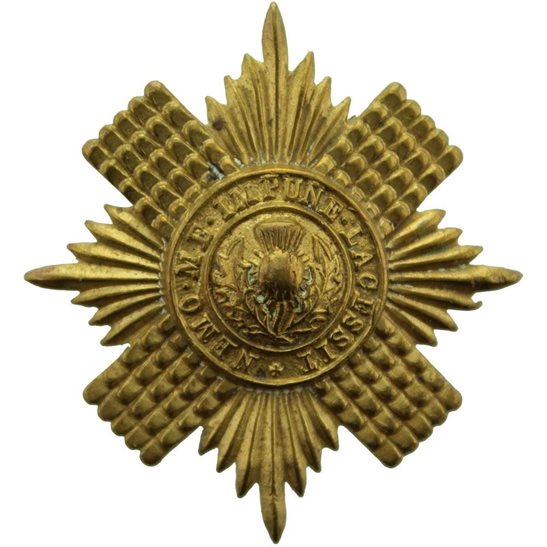Personal Details
Born: 6 April 1878 in Hollyhurst, near Whitchurch, Shropshire and baptised on 26 May the same year in St. Michael’s Parish Church, Marbury, Cheshire.
Family: He was the second of eight children born to Stephen Charles Evans, a rural postman, and his wife Sarah Harriet. He married Cissie Gaughan in 1918 in Liverpool; no children can be traced for the marriage.
Residence: In 1881 he lived at Combermere Lodge, Whitchurch with his parents and siblings; by 1891 they had moved to St. John’s Street, Whitchurch. By 1901 the family had moved to 14 Brownlow Street, Whitchurch but James was serving with the Scots Guards in the Boer War in South Africa. In 1911 he was boarding at 50 Ramsbottom Street, Monks Coppenhall, Crewe, Cheshire. His service papers show his mother living at Coal Wharf, Grindley Brook with his wife initially living in Grindley Brook and then at 44 Melville Place, Liverpool, Lancashire; his service attestation gives his address as Grindley Brook, Whitchurch; the 1919 Absent Voters’ Register indicate he lived at 16 Grindley Brook. he was discharged to 243 West Street, Crewe, Cheshire, but his pension record has an address in 1919 of 63 Ramsbottom Street, Crewe.
Employment: He was a postman when he joined the army in 1897; records show he was employed by London and North Western Railway in 1902 and in 1911 he was a fitting shop labourer; his military attestation in 1914 stated he was a postman.
Died: In 1937 at Bicton Mental Hospital, Shrewsbury, aged 59 and was buried on 24 May the same year in Whitchurch cemetery.
Military Details
Regiment: Scots Guards
Rank: Lance Corporal
Service Number: 9582 (previously 1619)
Date of Enlistment: 29 August 1914
Date of Discharge: 2 April 1919
Reason for Discharge: Demobilisation
Other Information:
James’ brothers Charles Stephen and Thomas Richard also served in WW1.
James originally joined the Scots Guards 7 September 1897, serving until 11 October 1902; this included in South Africa in the Boer War. He was placed on the reserve list, re-enlisting 29 August 1914.
James was awarded the Campaign Medals (1914 Star with clasps and roses, British War Medal, and Victory Medal)

The 1914 Star (also known as 'Pip') was authorised under Special Army Order no. 350 in November 1917 and by an Admiralty Fleet Order in 1918, for award to officers and men of the British and Indian Expeditionary Forces who served in France or Belgium between 5 August and midnight of 22–23 November 1914. The former date is the day after Britain's declaration of war against the Central Powers, and the closing date marks the end of the First Battle of Ypres.
The 1914–15 Star (also known as 'Pip') was instituted in December 1918 and was awarded to officers and men of British and Imperial forces who served against the Central European Powers in any theatre of the Great War between 5 August 1914 and 31 December 1915. The period of eligibility was prior to the introduction of the Military Service Act 1916, which instituted conscription in Britain.
The British War Medal (also known as 'Squeak') was a silver or bronze medal awarded to officers and men of the British and Imperial Forces who either entered a theatre of war or entered service overseas between 5th August 1914 and 11th November 1918 inclusive. This was later extended to services in Russia, Siberia and some other areas in 1919 and 1920. Approximately 6.5 million British War Medals were issued. Approximately 6.4 million of these were the silver versions of this medal. Around 110,000 of a bronze version were issued mainly to Chinese, Maltese and Indian Labour Corps. The front (obv or obverse) of the medal depicts the head of George V. The recipient's service number, rank, name and unit was impressed on the rim.
The Allied Victory Medal (also known as 'Wilfred') was issued by each of the allies. It was decided that each of the allies should each issue their own bronze victory medal with a similar design, similar equivalent wording and identical ribbon. The British medal was designed by W. McMillan. The front depicts a winged classical figure representing victory. Approximately 5.7 million victory medals were issued. Interestingly, eligibility for this medal was more restrictive and not everyone who received the British War Medal ('Squeak') also received the Victory Medal ('Wilfred'). However, in general, all recipients of 'Wilfred' also received 'Squeak' and all recipients of The 1914 Star or The 1914/1915 Star (also known as 'Pip') also received both 'Squeak' and 'Wilfred'. The recipient's service number, rank, name and unit was impressed on the rim.

